Eucalypt forest fact sheet
What is an eucalypt forest?
An eucalypt forest is a type of Australian ecosystem where tall gum trees form an open tree canopy. Most trees are over 10 metres high and their crowns (the top branches and leaves) reach across to touch and create a leafy roof over the forest.

There are over 700 species of eucalypt trees in Australia, commonly referred to in English as gum trees. The Darug name for gum tree is yarra.
Fast facts – Eucalypt forest
Location – Common on Hawkesbury sandstone ridges and slopes around Sydney, including Field of Mars Reserve in the Lane Cove River catchment.
Conditions – Dry, sunny sites with shallow, sandy, nutrient-poor soils and frequent fire.
Forest structure – Three main layers – tall eucalypt trees, a shrubby understorey and a diverse ground cover of grasses, ferns and small herbs.
Plants – Sydney red gum, scribbly gum, Sydney peppermint, banksias, kunzea, grass trees, paper-barks, bracken and native ground covers.
Animals – Possums, wallabies, bandicoots, echidnas, reptiles, powerful owls, kookaburras and a wide variety of smaller birds and invertebrates.
Why they matter – Provides habitat for many native species, protects soils, stores carbon and is one of Australia’s most widespread native forest types.
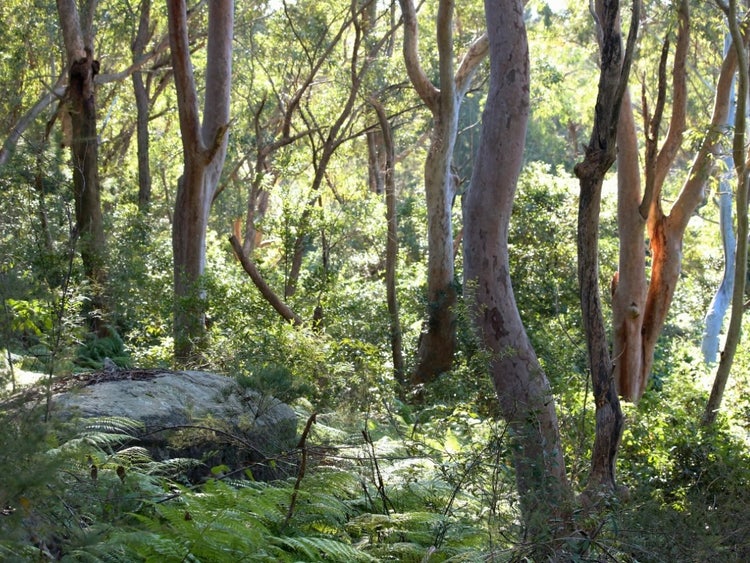
Eucalypt forests usually have 3 vegetation layers – the tree canopy layer, a shrub layer and a ground cover layer.
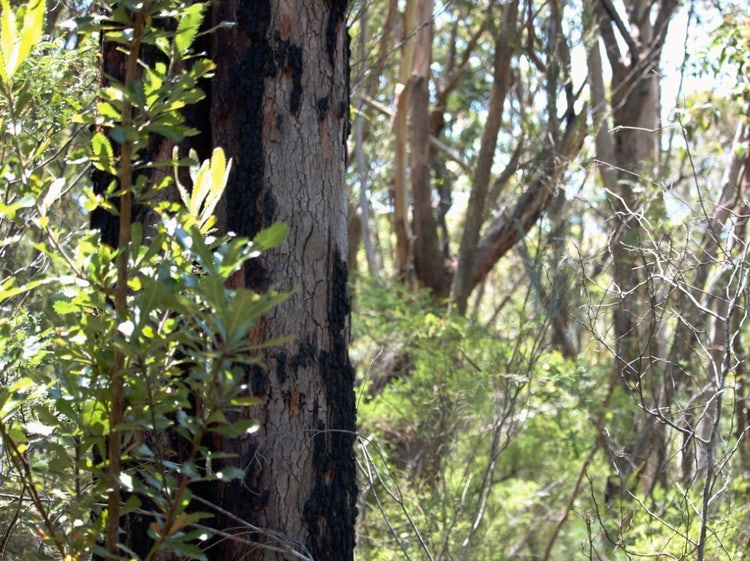
Many species in eucalypt forests require fire to encourage seed germination. The trunk of this eucaplypt shows evidence of a bushfire.
Where are eucalypt forests found?
Eucalypt forests grow in many parts of Australia wherever there is enough rainfall. They occur across much of the continent in equatorial, tropical, subtropical and temperate climate zones, usually around the outer edges of Australia.

Isoline map of Australian climate classifications
What is an eucalypt forest like?
Climate and topography
The climate of an area – including temperature, rainfall and seasonal changes – helps determine what type of eucalypt forest can grow there and which species it contains. In temperate parts of NSW, eucalypt forests grow where there is enough rainfall throughout the year to support tall trees.
The topography – the shape of the land – also affects the forest. Cliffs, ridges, slopes and valleys receive different amounts of sunlight, wind and moisture. For example, sheltered valleys may support taller, denser forests, while exposed ridge tops often have shorter, more stunted trees and a different mix of species.

The types of eucalyptus species found in the sheltered valleys of the Blue Mountains National Park is different to those growing on the exposed cliffs and ridge tops.
Soil and forest structure
Soil type has a big influence on what grows in an eucalypt forest. On sandy, nutrient-poor soils, such as those developed on Hawkesbury sandstone, the understorey is often dominated by hard, tough and sometimes prickly-leaved shrubs like banksias, grass trees and other dry sclerophyll plants. On deeper, clay-rich soils, which hold more nutrients and moisture, the ground cover layer is more likely to be made up of small herbs and grasses.
As the trees grow, they drop leaves, bark and branches to the ground, building up leaf litter. This layer helps protect the soil, keep in moisture and create important microhabitats for many small animals and decomposers.

The soil found in the Field of Mars Reserve is sandy and nutrient poor. Sydney red gums, hairpin banksias and mat rush all have special adaptations to help them thrive in these areas.
Fire in eucalypt forests
Fire is a natural part of many eucalypt forests. Some species need fire to trigger seed release or germination, while others can grow from protected buds after a fire. However, both too frequent and too infrequent fires can change the structure and health of the forest.

Eucalypt forest regrowing after a bushfire in Wollemi National Park.
What plants grow in eucalypt forests?
Eucalypt forests contain a variety of trees from the Eucalyptus, Corymbia and Angophora genera. These trees provide food, nesting sites and shelter in their trunks, branches and hollows, forming essential tree habitats for many species.
Beneath the canopy, the shrub layer includes plants such as wattles, banksias and smaller native shrubs like eggs and bacon, which produce flowers rich in nectar and pollen for bees, birds and other pollinators. Vines such as native sarsaparilla climb through shrubs and small trees, using them for support.
On and in the leaf litter, tiny organisms carry out important work. Fungi grow on fallen logs and leaf litter, breaking down dead plant material and recycling nutrients back into the soil. Invertebrates such as bush cockroaches, slaters, centipedes and worms help shred and mix this material, speeding up decomposition.
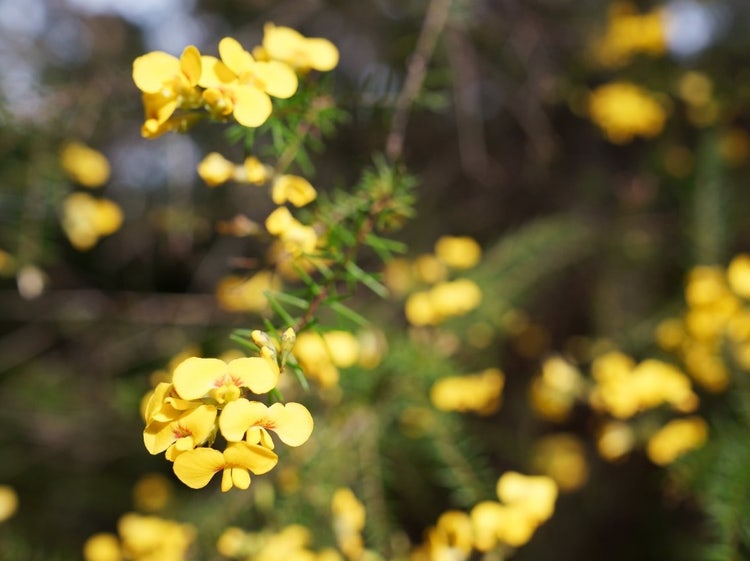
Eggs and bacon is a type of small shrub found in a eucalypt forest. Pollen is collected from their flowers by pollinating animals such as bees and birds.
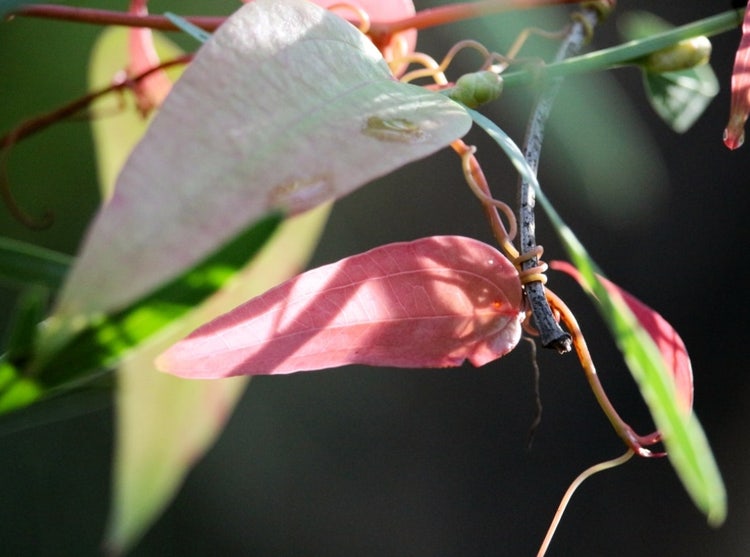
Native sarsaparilla is a type of vine that grows in the ground cover layer up through the branches of shrubs.
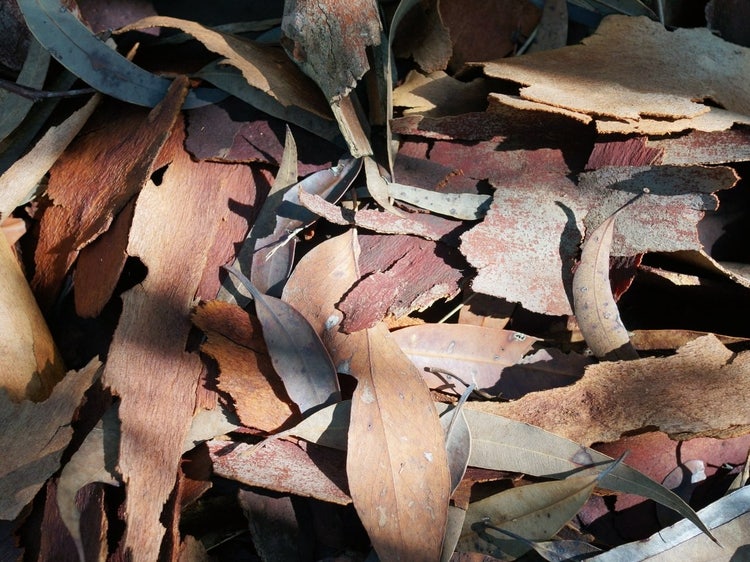
As eucalypt trees grow they drop leaves, branches and bark to the ground. This is called leaf litter and is an important habitat for animals such as bush cockroaches, slaters and centipedes.
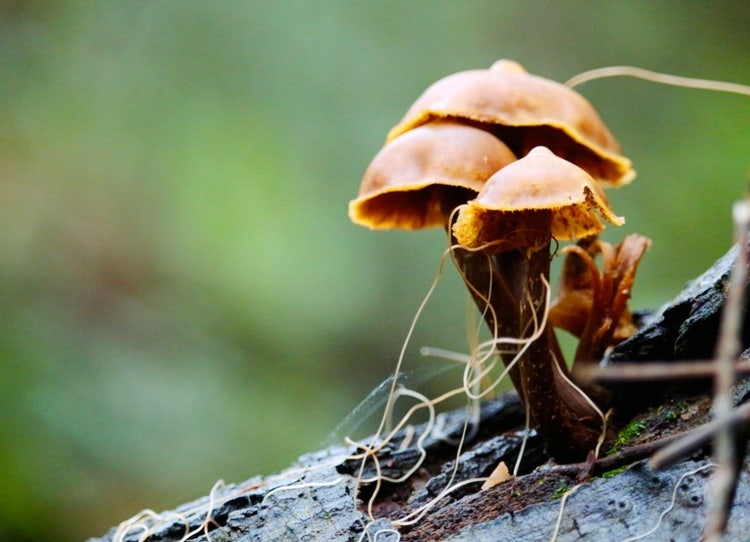
Fungi are important decomposers breaking down dead plants and recycling essential nutrients back into the ecosystem.
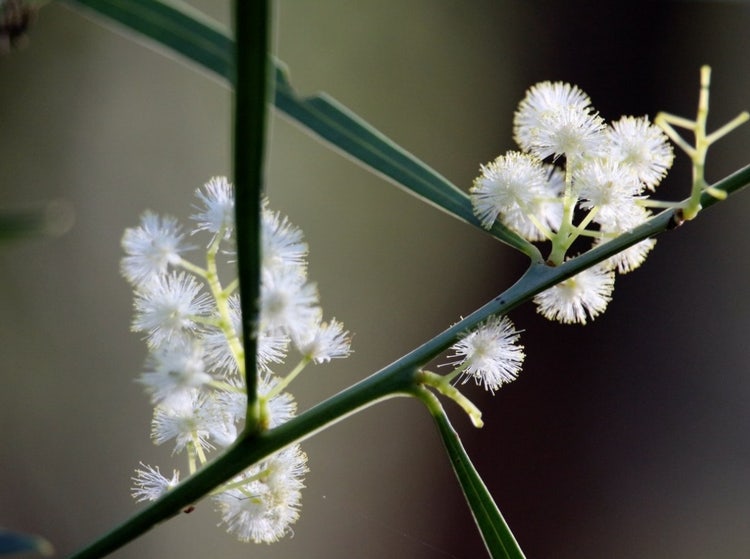
Wattles are a type of shrub that commonly grow in eucalypt forests.

Kangaroo grass in the ground cover layer provides food for seed-eating birds and shelter for lizards.
What types of animals live in eucalypt forests?
Eucalypt forests provide homes for a wide range of fauna. In the trees, ringtail possums build nests high in the branches, while birds such as rainbow lorikeets, kookaburras and powerful owls use tree branches and hollows for perching, nesting and roosting. Nectar-feeding birds help pollinate gum trees and flowering shrubs as they feed.
On the trunks and branches, reptiles such as eastern water dragons bask in the sun or climb to escape predators, while geckos and skinks hunt insects. On the ground and in leaf litter, small mammals like wallabies and bandicoots search for shoots, roots and invertebrates, and amphibians such as red-crowned toadlets use moist habitats under rocks and logs. Slugs, snails, insects, arachnids and many other invertebrates live throughout the forest, forming important links in the food web.
Why eucalypt forests are important
Eucalypt forests support high biodiversity by providing many different habitats – from tree hollows and bark to shrubs, grasses, leaf litter, rocks and logs. They help protect soils from erosion, store carbon in their wood and soils, and influence local climate and water cycles.
These forests are also important for people. They are places for recreation, education and research, including school excursions to Field of Mars Environmental Education Centre. Eucalypt forests have deep cultural significance for Aboriginal peoples, who have long relied on these environments for food, medicine, tools and cultural practices.

Rainbow lorikeets are mainly nectar feeders and help pollinate eucalypts and flowering shrubs. They nest in hollows in tree trunks and branches.
Threats to eucalypt forests
In many parts of NSW, eucalypt forests are under pressure from urban development, land clearing, roads and other infrastructure. These activities can fragment the forest, reduce habitat area and make it harder for animals and plants to move between patches.
Other threats include weed invasion, changes to natural fire regimes and nutrient enrichment from urban runoff. Weeds can outcompete native plants, while altered fire patterns may prevent some species from regenerating or favour others. Introduced animals and domestic pets can prey on native wildlife, further stressing these ecosystems.
Related Fact Sheets
Environments & ecosystems
Habitats
- Leaf litter habitats fact sheet
- Ground cover habitats fact sheet
- Shrub habitats fact sheet
- Tree habitats fact sheet
- Rock and log habitats fact sheet
Plants commonly found in eucalypt forest
- Grass tree fact sheet
- Bracken fern fact sheet
- Hairpin banksia fact sheet
- Old man banksia fact sheet
- Scribbly gum fact sheet
- Sydney peppermint fact sheet
- Sydney red gum fact sheet
Animals commonly found in eucalypt forests
Mammals
- Common ringtail possum fact sheet
- Long-nosed bandicoot fact sheet
- Swamp wallaby fact sheet
- Short-beaked echidna fact sheet
- Grey-headed flying fox fact sheet
Birds
- Powerful owl fact sheet
- Australian magpie fact sheet
- Laughing kookaburra fact sheet
- Superb fairy wren fact sheet
Reptiles & invertebrates

Find out more
Written by teachers, Eucalypt Forest is an exciting digital book which explores the beautiful natural environment of the Australian eucalyptus forest.
Learn about the interactions between plants and animals in the forest and how people can interact with and care for these special natural areas.
Containing a suite of interactive activities, videos and beautiful images, this book will encourage you to go out and explore your local eucalypt forest.
Attributions
References
Australian National Botanic Gardens. (n.d.). Eucalypts – overview and species information. Department of Climate Change, Energy, the Environment and Water. https://www.anbg.gov.au
Biondo, E., & Wilson, K. (2020). Australian forests and their ecology. CSIRO Publishing.
Department of Planning and Environment NSW. (2022). Native vegetation of the Sydney Basin Bioregion. NSW Government. https://www.dpie.nsw.gov.au
Lane Cove National Park – NSW National Parks and Wildlife Service. (n.d.). Dry sclerophyll forest ecosystems. NSW Government. https://www.nationalparks.nsw.gov.au
Royal Botanic Garden Sydney. (n.d.). Sydney sandstone flora and ecosystems. https://www.rbgsyd.nsw.gov.au
Smith, A. (2018). Australian eucalypt forests: structure, fire, and biodiversity. CSIRO Publishing.
University of Sydney Institute of Agriculture. (n.d.). Soils of the Sydney Region. https://www.sydney.edu.au
Image attributions
Rainbow lorikeets are mainly nectar feeders and help pollinate eucalypts and flowering shrubs. Rainbow Lorikeet feeding on a lemon myrtle tree by James Niland on Flickr. Licensed under CC BY 2.0
All other images - Field of Mars EEC